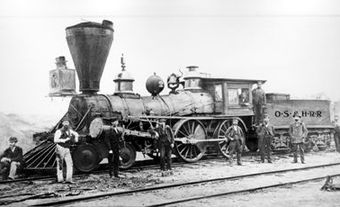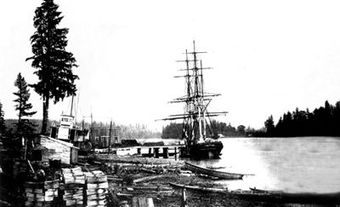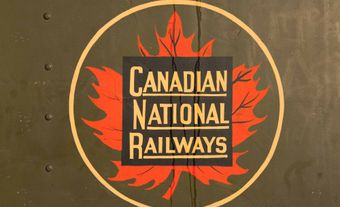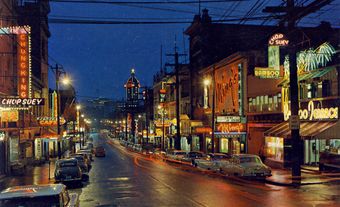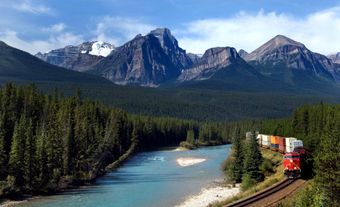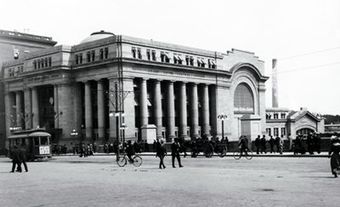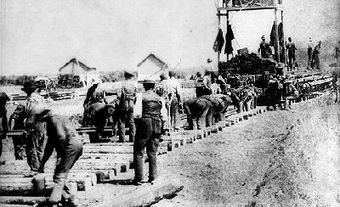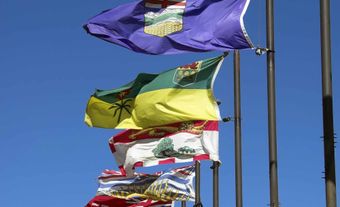The Canadian Pacific Railway company (CPR) was incorporated in 1881. Its original purpose was the construction of a transcontinental railway, a promise to British Columbia upon its entry into Confederation (see Railway History). The railway — completed in 1885 — connected Eastern Canada to British Columbia and played an important role in the development of the nation. Built in dangerous conditions by thousands of labourers, including 15,000 Chinese temporary workers, the railway facilitated communication and transportation across the country. Over its long history, the Canadian Pacific Railway diversified its operations. The company established hotels, shipping lines and airlines, and developed mining and telecommunications industries (see Shipping Industry; Air Transport Industry). In 2001, Canadian Pacific separated into five separate and independent companies, with Canadian Pacific Railway returning to its origins as a railway company. CP, as it is branded today, has over 22,500 km of track across Canada and the United States. It is a public company and it trades on the Toronto Stock Exchange and the New York Stock Exchange under the symbol CP. In 2020, CP reported $7.71 billion in total revenues.
This is the full-length entry about the Canadian Pacific Railway. For a plain-language summary, please see The Canadian Pacific Railway (Plain-Language Summary).
Indigenous Lands
In 1870, the newly created nation of Canada acquired Rupert’s Land from the Hudson’s Bay Company, an enormous tract of land stretching north and west. One year later, British Columbia entered Confederation based in part on the promise that a transcontinental railway would connect it to the rest of Canada within 10 years (see Railway History). In order to construct the railway and encourage future settlement, the government considered it necessary to extinguish Indigenous title to the land (see Indigenous Territory). Bound by the terms of the Royal Proclamation, Canada was responsible for both the protection of Indigenous peoples and the preservation of their rights to unceded traditional territories.
In order to procure land for the construction of the railway, a series of treaties, known as the Numbered Treaties, were negotiated. Between 1871 and 1877, Numbered Treaties 1 to 7, were established. Treaties 1 to 7 solidified Canada’s claim to lands north of the United States-Canada border. The treaties enabled the construction of a national railway and opened the lands of the North-West Territories to agricultural settlement.
Government negotiators made various promises to First Nation peoples in exchange for their traditional territory. These promises, which were made orally and in the written texts of the treaties, included special rights to treaty lands and the distribution of cash payments, hunting and fishing tools and farming supplies. These terms of agreement are controversial and contested. The Numbered Treaties have ongoing legal and socioeconomic impacts on Indigenous communities.
National Imperative
Competition for the lucrative transcontinental railway contract was bitter. In 1872, shipping magnate and railway promoter Sir Hugh Allan was awarded the charter. However, Allan had also contributed around $350,000 to the Conservative party’s election campaign. When this became public knowledge in 1873, Sir John A. Macdonald 's government was forced to resign (see Pacific Scandal).
Macdonald returned to power in 1878, with the completion of the railway as one facet of his National Policy. The railway contract was finally awarded to interests led by Donald A. Smith, J.J. Hill and George Stephen. The Canadian Pacific Railway was incorporated on 16 February 1881. The difficulties of construction and demand for early completion of the line ensured generous provisions to the company, including $25 million in cash, 25 million acres (about 10 million hectares) of land in a belt along the railway, the cost of surveys totalling $37 million and the monopoly over transportation south to the United States for 20 years. Due to the high cost of construction, the CPR would later receive an additional $22.5 million in loans under the Railway Relief Act of 1884.

These terms were loudly denounced by opposing interests at the time and remained contentious with the development of the Prairie West (see History and Settlement in the Canadian Prairies). However, in the face of American expansion westward, Macdonald and the federal Conservatives considered completion of the railway a national imperative.
Take the quiz!
Test your knowledge of Canadian history by taking this quiz, offered by the Citizenship Challenge! A program of Historica Canada, the Citizenship Challenge invites Canadians to test their national knowledge by taking a mock citizenship exam, as well as other themed quizzes.
Construction
Under the management of W.C. Van Horne, construction was rapidly pressed across the plains. Sandford Fleming had recommended a route through the Yellowhead Pass but a more southerly route through Kicking Horse Pass was decided upon in 1881. Construction through the rock and muskeg of the Canadian Shield almost equalled in difficulty the engineering feats required to build through the mountains of British Columbia.
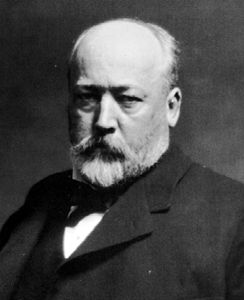
The difficulty in obtaining an adequate work force in British Columbia led to the controversial employment of thousands of Chinese workers ( see History of Labour Migration to Canada). Upward of 15,000 Chinese labourers helped to build the Canadian Pacific Railway. Working in harsh conditions for little pay, these workers suffered greatly and historians estimate that at least 600 died working on the railway. The employment of Chinese workers caused controversy, particularly in British Columbia, where politicians worried about the potential economic and cultural impact of these workers.
Did you know?
When the CPR was finished in 1885, the government passed the Chinese Immigration Act, which established a head tax for anyone of Chinese origin entering the country. The government also passed the Electoral Franchise Act, which excluded “persons of Mongolian or Chinese race” from voting (see Right to Vote in Canada).
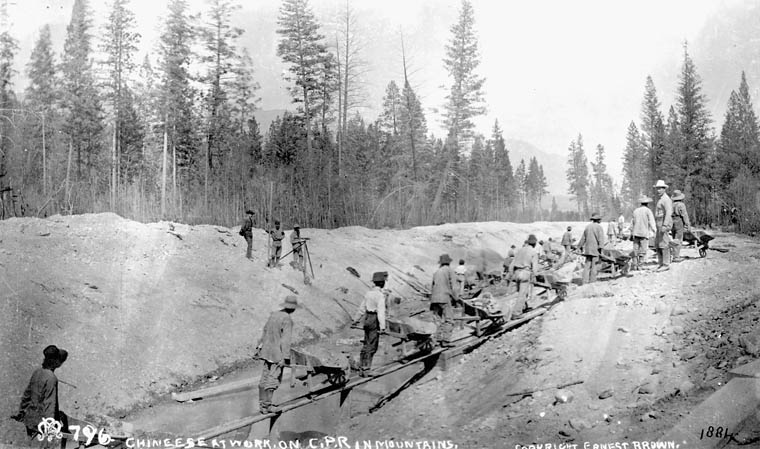
The line through to the Pacific coast was completed on 7 November 1885 with the driving of the "Last Spike" at Craigellachie in Eagle Pass, British Columbia. The first through passenger train left Montreal on 28 June 1886 and arrived at Port Moody, British Columbia, on 4 July.
Did you know?
Although sections of the track were not quite complete, the section from Callander to Port Arthur (Thunder Bay), Ontario, was used to move troops westward during the North-West Resistance, though it was not quite complete.
Developing Business
During construction, the CPR became involved in the sale and settlement of land (1881), the acquisition of the Dominion Express Company (1882) and the acceptance of commercial telegraph messages (1882). The company provided its own sleeping and dining cars on trains and constructed tourist hotels (e.g., at Lake Louise, Alberta) and dining halls along the route in the western mountains. This foothold on the tourist industry benefited the CPR later in its international development of hotels, steamships and airlines (see Hotel; Tourism).
Did you know?
In the first decades of the 20th century, the job of a sleeping car porter was one of the few positions available to Black men in Canada. Sleeping car porters were railway employees who attended to passengers aboard sleeping cars. While the position carried respect and prestige for Black men in their communities, the work demanded long hours for little pay. Porters could be fired suddenly and were often subjected to racist treatment.
Following construction, the greatest challenge facing the CPR was to develop business to make the line self-sustaining. Though settlement proceeded rapidly in the wake of the rail lines, the population in western Canada was insufficient to sustain the line fully for many years. To increase business, the corporation became very active in promoting trade in the Pacific. Within days of the arrival of the first train on the west coast in 1886, sailing vessels chartered by the CPR began to arrive from Japan, bringing tea, silk and curios. By 1891, the company had secured a contract from the British government to carry the imperial mails from Hong Kong to Britain via Canada. The result was the purchase of three ocean passenger-cargo vessels, forerunners of the present-day fleet.
Hotels
By 1900, the mountain hotel system had expanded into the major cities, led by the Hotel Vancouver (1887), Québec's Château Frontenac (1893) and Montreal's Place Viger (1898) ( see Hotel; Tourism). Other services expanded simultaneously. A line was opened (1889) across northern Maine from Montréal to Saint John, giving the CPR direct access to an all-weather Atlantic port.
Rail Construction
Attempts to capture traffic from the western American states were made with the construction of a line to North Dakota (1893) and the eventual consolidation of what is now the Soo Line Railroad Company in the United States. Branch lines were greatly extended to feed traffic to the East-West main line. Rapid settlement followed construction of branches in southern Manitoba, in Saskatchewan from Regina to Prince Albert (1890), and in Alberta from Calgary North to Strathcona (Edmonton) in 1891.
Mining
Expansion into the Kootenay mining region of southern British Columbia (1898) involved the acquisition of a railway charter that included a smelter at Trail, BC. This was the nucleus of the CPR's involvement in mining and metallurgy, formalized by the formation of Cominco Limited in 1906, a CP-controlled company (in 2001, Cominco was acquired by Teck, another mining company).
Fleet
The CPR’s Pacific fleet was improved and, in 1903, the company purchased the Beaver Line shipping company and opened service in the North Atlantic. In 1909, CPR purchased the long-established Allan Line, and formed Canadian Pacific Ocean Services in 1914–5. After 1921, it became known as Canadian Pacific Steamships Limited.
Expansion and Competition
Between 1899 and 1913, the CPR increased its trackage from approximately 11,200 km to 17,600 km. More than half of the new track was in the Prairie provinces, and it was intended both to provide branch lines into areas of need and to ensure that the CPR would remain competitive in relation to the developing transcontinental lines of the Canadian Northern Railway and the Grand Trunk Pacific Railway.
The widespread expansion of the company, much of it under the presidency of T.G. Shaughnessy (1899-1918), placed a heavy drain on company resources, but continuance of the National Policy, with its substantial tariffs, meant continuing high freight rates in the West.
Attacks on these rates in 1896 helped to bring about the defeat of the Conservatives. The Liberals reduced rates with the Crow's Nest Pass Agreement in 1897 and, under the Manitoba Grain Act of 1900, required railways to provide loading platforms for farmers. Charters were also granted to the Canadian Northern Railway to develop the huge area of northern prairie left vacant by the CPR.
Canadian National Railway (CNR), formed by the government of Canada between 1917 and 1923, was a major challenge for the CPR. The CNR consolidated the failing Grand Trunk Pacific, Canadian Northern, Intercolonial and Canadian Government Railways. The CNR also competed with the CPR in hotels, telegraphs, steamships and express services as well as railway services.
Second World War
Despite this massive, government-supported competition, CPR survived as a commercial enterprise. During the Second World War it provided not only transportation, but also the production of armaments and materiel in its own shops. During the conflict, much of its merchant fleet was commandeered for military transport purposes, resulting in the loss of 12 vessels.
Airlines
Canadian Pacific Air Lines (later CP Air) was organized in 1942 with the purchase of Grant McConachie's Yukon Southern Air Transport and numerous other flying concerns. After 1947, under McConachie's leadership, CPA developed into an international carrier serving the Far East, Australasia, most of South America and several European countries (see Aviation). In 1987, CP Air was acquired by Pacific Western and the two companies began operations as Canadian Airlines International (CAI). It was later expanded with the purchase of Wardair. A rigorously competitive market and government regulation caused significant changes to the airline industry in the 1990s. CAI was taken over by Air Canada in 2000.
Diversification
Until the late 1950s, CP's diverse interests were looked upon as ancillary to the rail system. Beginning around this time, management embraced a policy of full diversification by making each operation fully self-supporting. Thus, operations that had been handled by specific departments in the railway corporate structure were set up as enterprises in their own right; e.g., Marathon Realty Co Ltd (1963), which took over the administration of real estate other than that required for railway use; CP Hotels Ltd (1965); and CP Oil & Gas Ltd (1958), which later became PanCanadian Energy Corporation.
Non-transportation interests were vested into a holding company called Canadian Pacific Enterprises Limited. Founded in 1962 this holding company left railway, air, ship and highway transportation fields under the jurisdiction of the parent company. In 1968, a new corporate identity program gave the names CP Rail, CP Ships, CP Transport and CP Air to the various transportation modes.
In 1967, the communications wing was integrated, along with CN's parallel organization, into a new, jointly owned company known as CNCP Telecommunications Ltd (see Telecommunications). In 1990, CNCP became Unitel Communications, which was later sold to other communications providers.
In 1971, to reflect its broader orientation, the company’s original name was altered to Canadian Pacific Limited (CPL).
Restructuring
In 1996, the company was restructured, with Canadian Pacific Railway becoming a subsidiary of the company rather than a division (in effect, CPR would operate independently, with no cross-subsidies from the other divisions). The company also sold several of its enterprises, including Marathon Realty (1996) and its interest in Laidlaw Inc. (1997).
In 2001, the company separated into five independent companies: Canadian Pacific Railway, CP Ships, PanCanadian Energy Corporation, Fording Coal and Canadian Pacific Hotels (renamed Fairmont Hotels & Resorts Inc.). The restructuring meant that CPR was once again purely a rail company.
PanCanadian merged with the Alberta Energy Company Limited in 2002 to become Encana, one of the world’s leading energy producers, while CP Ships was sold to a German conglomerate in 2005, becoming part of the Hapag-Lloyd shipping company. Fording Coal was purchased in 2008 by Teck Cominco.

 Share on Facebook
Share on Facebook Share on X
Share on X Share by Email
Share by Email Share on Google Classroom
Share on Google Classroom







